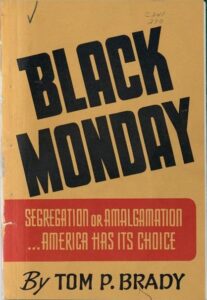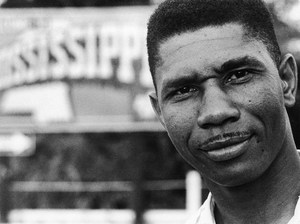
Image source: Library of Congress
On May 27, 1954, future Mississippi Supreme Court Justice Tom P. Brady (pronounced “BRAD-dee”) delivered a racist speech called “Black Monday” in response to the U.S. Supreme Court’s Brown v. Board of Education decision (delivered ten days earlier, on Monday, May 17), inspiring many white leaders to join the White Citizens’ Council.
The diatribe was first delivered as a speech to the Sons of the American Revolution, and later printed as a 92-page booklet that was distributed to white schoolchildren across Mississippi.
The Mississippi Encyclopedia describes the book,
Black Monday, a combination of legal arguments and specious anthropological ideas, called for the popular election of Supreme Court justices, a youth education program on ethnology and communist infiltration, the elimination of the National Association for the Advancement of Colored People, the abolition of public schools, and the creation of a forty-ninth state for African Americans. Brady also argued that the separation of the races preserved an orderly society and that a disregard for southern mores would create racial turmoil. He urged white citizens to prevent racial amalgamation.
Black Monday won accolades from segregationists and other conservatives and raised money for the White Citizens’ Council. Brady was an architect of that group, helping to write its charter and bylaws and traveling the country as its spokesperson. He viewed the Council as a peaceful organization that could stop a race war and serve as the core of a new grassroots conservative party to thwart the encroachment of socialism and the disregard for law at the federal level.
The speech also fueled the fanaticism of Byron De La Beckwith, who sold Black Monday pamphlets outside the governor’s mansion and later murdered NAACP leader Medgar Evers.
Award winning journalist Jerry Mitchell wrote about Brady’s speech in the Clarion Ledger, History: Dred Scott freed, Mississippi sit-in attacked.








Twitter
Google plus
LinkedIn